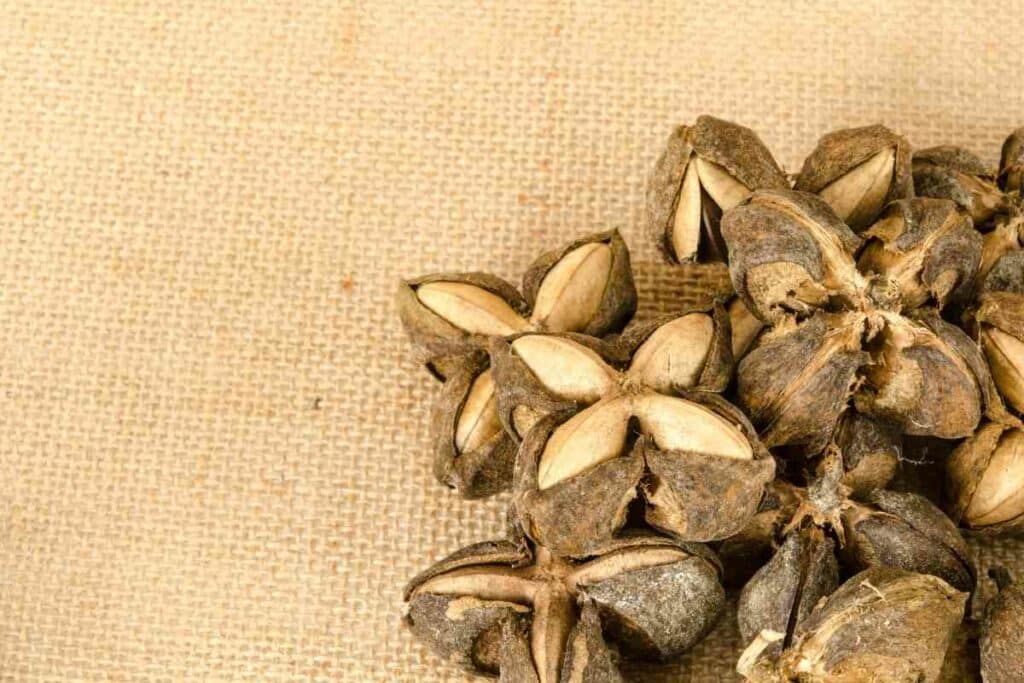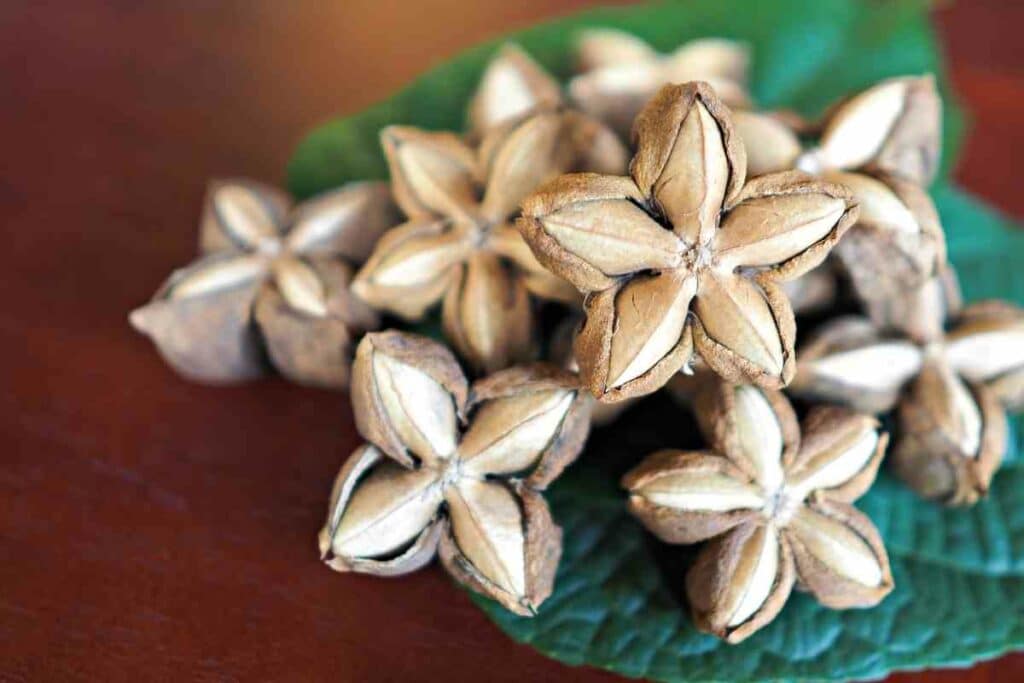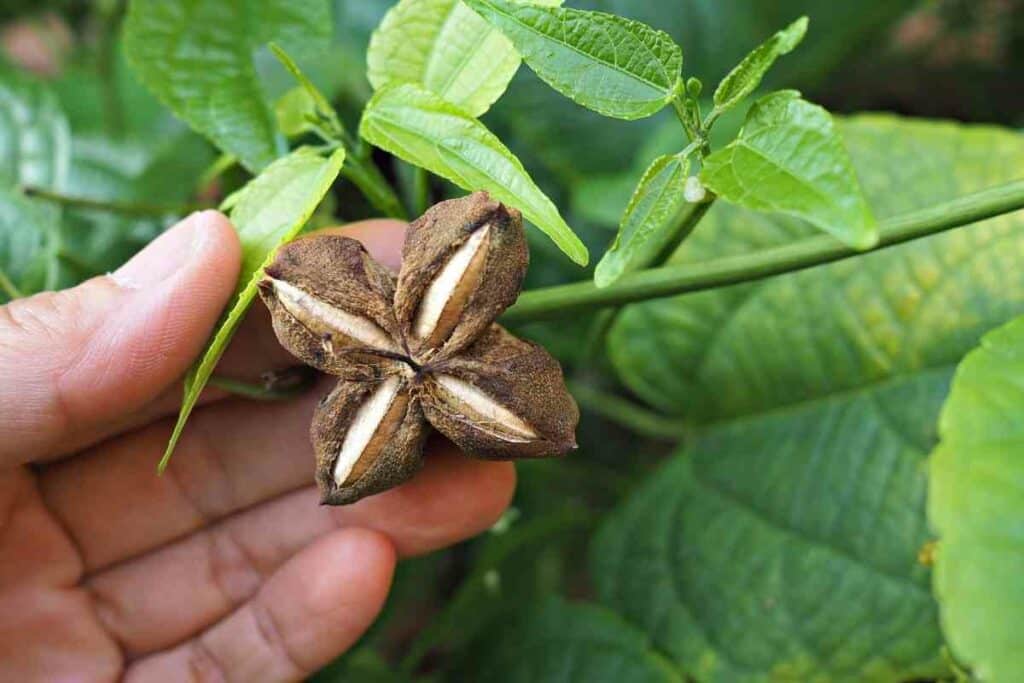If you are looking for the next superfood, you can look no further than sacha inchi.
This power plant hails from the continent that brought the world quinoa, maca root, and acai berry.
Growers are keen to cultivate this valuable perennial that has amazing productivity with its delicious leaves and seeds.

You can grow your sacha inchi plants and benefit from its remarkable nutty seeds, probably saving you thousands of dollars at the health food store.
What to Expect? Read on to learn the essentials of cultivating Sacha inch and build resilience by adding this valuable food source to your garden.
What is sacha inchi?
Plukenetia Volubilis or sacha inchi is a South American perennial plant that is present in tropical countries like:
- Suriname
- Bolivia
- Peru
- and parts of Brazil and the Caribbean
Other names of this plant include:
- Mountain peanut
- Inca nut
- Inca peanut
It is also commercially cultivated for its seeds and leaves in Southeast Asia which are edible after roasting.
Sacha Inchi has a long history of cultivation in South America and the nutritional benefits of its seed continue to be prized by the indigenous peoples of Peru and other countries.
Sacha Inchi plant and fruit
Sacha inchi plants are tall shrubs or vine-like plants that can reach heights of up to 2 meters.
It is native to rainforests and thrives in alluvial soils with slight acidity. With water and good drainage, it can also grow at altitudes of up to 1700 meters.

Sacha inchi has alternatively spaced large and serrated leaves.
It is monoecious, possessing both male and female flowers on the plant, and produces small white clusters of self-fertilizing flowers that give rise to its seeds.
This is a highly productive plant that is perfect for a forest garden as it is productive all year round.
A mature plant can produce up to 500 seeds per year. The capsular fruit is star-shaped with 4 to 7 points and a diameter of 5 centimeters.
Within are oval dark brown seeds of 1 to 2 centimeters in length. They are inedible raw, but become a nutritious nut after drying shelling, and roasting.
A nutritious seed to harvest

Sacha inchi is primarily grown for its delicious seeds that have numerous nutrients including:
- high protein
- omega-3 linolenic acid
- omega-6 linoleic acid
- omega-9 linoleic acid
The fatty acids of the Sacha inchi seed have been shown to reduce HDL cholesterol levels.
With a 35 – 60% oil content, these seeds can be pressed into a nutty oil with a mild flavor for cooking or dressing.
You can brew even the leaves of the plant as tea. These benefits have made it a valuable cash crop for many communities.
Here’s a video of what is great about Sacha inchi:
Sacha inchi growing conditions
To grow and fruit, Sacha inchi needs the right climate and conditions.
It is a tropical plant, native to jungles and rainforests, so you need to have that in mind when growing.
Here are the three key growing conditions for Sacha inchi.
Sacha inchi is sun-loving
Sacha inchi needs sustained heat and intense sunlight to grow effectively.
It is best suited to the USDA plant hardiness zone 10, with minimum temperatures between 30 °F and 35 °F (-1.1 °C and 1.7 °C).
Locations like SoCal, Florida, and Hawaii are where Sacha inchi is going to thrive. Plant Sacha inch in full sun to partial shade.
Plant in slightly acidic soil
The native soils this plant enjoys are highly fertile, with sand and silt to provide good drainage.
A medium-textured clay or sandy loam is ideal. Sacha inchi also loves high concentrations of aluminum!
Recreate this nourishing soil for your Sacha inchi plant by adding organic matter or an NPK fertilizer.
Keep In Mind – This plant is highly adaptable. Soil pH should be moderately acidic, between pH 4.5 and 6.0.
Water Sacha inchi liberally
Being a plant that grows near rivers, Sachi inchi appreciates moist but not waterlogged soils.
Water regularly as these are thirsty plants, but ensure that they have adequate drainage.
How to grow Sacha inchi
Sacha inchi can be propagated by grafting, but techniques for consistently reproducing the plant from cuttings have not been described widely.

This leaves starting Sacha inchi from seed as the main way of growing these shrubs.
You can grow from seed by using a good quality seed from a reputable retailer.
1. Start Sacha inchi from seeds
To start Sacha inchi from seeds, you need to purchase fertile, untreated seeds (not roasted nuts). They should be soaked in clean water in darkness for at least 24 hours.
They need to be kept at a temperature between 77 °F and 86 °F (25°C and 30°C) on a moist piece of kitchen towel.
Germination takes up to 14 days. The germinated seed can be planted in small pots with potting compost and started indoors. You can then transplant the young plants once established.
Important – Sacha inchi seeds should be disinfected before sowing, to protect the developing plant from fungal diseases that destroy the plant’s roots. You can do this by mixing the dry seeds with a watery paste of fungicide and insecticide until they are saturated.
2. Sow direct or transplant in well-irrigated soil
If you have well-irrigated land, you can plant your seedling any time during the year.
Seedlings are planted between 45 and 60 days post-germination.
An intermediate transplanting to black plastic bags filled with soil can be done, but the plant should be in the soil by 60 days (when the fourth or fifth pair of leaves have sprouted).
Plant on level land with some slope to ensure good drainage.
You can plant multiple plants in a 30cm deep furrow at 1-meter intervals. Prep the soil with manure, to feed your plants as they grow.
3. Use leveling to ensure that good drainage

Because Sacha inchi needs a lot of water you need to ensure that the land drains properly and there is no opportunity for water to pool and rot the plant roots.
4. Looking after young Sacha inchi plants
Young Sacha inchi plants require active cultivation that includes:
- Weeding
- Pest control
- Support (see below)
In South America, it is often grown alongside companion plants that are common to the region including:
- Banana
- Beans
- Corns
- Cassava
Leguminous species have the added benefit of fixing and adding nitrogen into the soil.
5. Support growing plants
A trellis system can be used to provide some structure for your growing plants.
You should install stakes and trellis on level ground before you transplant the seedlings to prevent them from becoming damaged.
Harvesting Sacha inchi
Sacha inch perennials can yield dry and mature fruits as soon as 7 months after transplanting.
The plant will continue to fruit and yield seeds after its first harvest, so be prepared to harvest your plants every 20 to 30 days.
- The best yield is between November and May
- Yields reduce between June and October
You should only harvest the brown seed capsules that are still on the plant.
Heads Up! Fallen fruits and seeds are a source of contamination. Yields should increase year on year until the third year.
Processing your Sacha inchi seeds
You should process all the seeds you collect at once and not mix them with other batches to prevent contamination.
The seeds need to be dried and threshed.
You can use a dehydrator, or solar dryer, or dry them in direct sunlight on a cement or stone surface.
The drying time is variable as it depends on the rate of dehiscence of the seed from the fruit.
Separated seeds need to be roasted before eating or pressing for oil.
Take a look at the commercial harvesting process to get an idea of what these steps entail:
Rounding up
Sacha inchi is a nutrition powerhouse, and if your garden has the weather it is a beautiful and productive exotic shrub to add.
As with many exotic plants, you should be prepared to experiment, learning as you go to establish your Sachi inch and grow your superfood!


